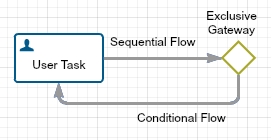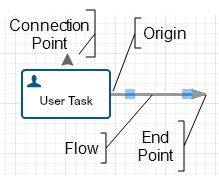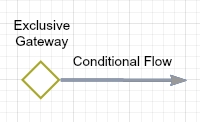Sequence Flow Shape
|
|
The sequence flow shape visually indicates the next step in a process. A conditional sequence flow shape is attached to a gateway shape and has defined rules before moving forward. The sequence flow and conditional sequence flow shape are used to connect two or more shapes together. |
Sequence Flow Shape
|
|
|
Draw Sequence Flow Shape
- Hover the mouse cursor over a shape. An arrowhead will appear on each side of the shape.
- Hover the mouse over an arrowhead until it is solid, click and drag an arrowhead away from the shape to extend a path.
- Hover over a shape until the connection point arrowheads appear, drop the endpoint when an arrowhead appears black. The endpoint will connect to the shape.
Conditional Sequence Flow Shape
|
|
When you draw a sequence flow from a gateway shape, a conditional sequence flow is created with a label, "Conditional Flow". |
| Origin | |
| Move origin to another gateway shape. | The label and rules are unchanged. |
| Move origin to a different connection point on the same gateway shape. | The label and the rules are unchanged. |
| Move origin to non gateway shape or canvas. | The label and rules are cleared. However, if you attach the origin back to a gateway shape, the label will return but the rules are lost. |
| Move origin to gateway shape from non gateway shape or canvas. | The label reverts to "Conditional Flow" with no rules defined. |
| End Point | |
| Drop end point to canvas. | The label and rules are unchanged. |
| Connect end point to another shape. | The label and rules are unchanged. |
Flow Properties Tab
See Configuring Process Properties for more information.
General Tab
The general tab contains the shape name and description.
| Field | Description |
|---|---|
| Name |
The shape name. Note: External shape names on the canvas may be repositioned. |
| Description | Additional information to clarify context. |
See Configuring General Options.
Validation
The Run Validation command on the Process menu lets you run a validation check at any time so you can address problems that may arise before you check in the process. The validation returns warning messages that indicate what needs to be fixed before the model can be checked in. The validation checks against the following:
| Field | Description |
|---|---|
| Data Versioning |
Checks the Data Dictionary for data object updates |
| BPMN |
Verifies that the model conforms to BPMN standards. |
| Configuration |
Ensures that process data elements have been configured correctly in the model. |
See Validating a Process Model
Shape Validation Tab
Shape property validation checks that data conforms to all input criteria, i.e. valid characters. Validation messages include the following:
| Field | Description |
|---|---|
| Warnings |
Indicate failed validation checks against BPMN and the fix required before the process may be deployed. Note: Models that fail validation can still be checked in but cannot be deployed. |
| Information |
May appear after validation checks of the data objects. For example, if you used a data object called "Salary" but a newer version exists, an information message tells you there is an updated version available. Note: These messages do not stop check in or deployment. You may continue to use the older version of the data object. |
Model Validation Tab
Model validation:
- Checks for master work item input data mappings.
- Verifies proper sequence flow connections.
- Lists information and warnings about the model configuration.
XTRAC Community |

|




